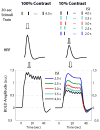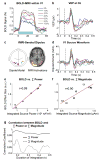Linear and nonlinear relationships between visual stimuli, EEG and BOLD fMRI signals
- PMID: 20079854
- PMCID: PMC2841568
- DOI: 10.1016/j.neuroimage.2010.01.017
Linear and nonlinear relationships between visual stimuli, EEG and BOLD fMRI signals
Abstract
In the present study, the cascaded interactions between stimuli and neural and hemodynamic responses were modeled using linear systems. These models provided the theoretical hypotheses that were tested against the electroencephalography (EEG) and blood oxygen level dependent (BOLD) functional magnetic resonance imaging (fMRI) data recorded from human subjects during prolonged periods of repeated visual stimuli with a variable setting of the inter-stimulus interval (ISI) and visual contrast. Our results suggest that (1) neural response is nonlinear only when ISI<0.2 s, (2) BOLD response is nonlinear with an exclusively vascular origin when 0.25<ISI<4.2 s, (3) vascular response nonlinearity reflects a refractory effect, rather than a ceiling effect, and (4) there is a strong linear relationship between the BOLD effect size and the integrated power of event-related synaptic current activity, after modeling and taking into account the vascular refractory effect. These conclusions offer important insights into the origins of BOLD nonlinearity and the nature of neurovascular coupling, and suggest an effective means to quantitatively interpret the BOLD signal in terms of neural activity. The validated cross-modal relationship between fMRI and EEG may provide a theoretical basis for the integration of these two modalities.
Copyright 2010 Elsevier Inc. All rights reserved.
Figures







Similar articles
-
Investigating the source of BOLD nonlinearity in human visual cortex in response to paired visual stimuli.Neuroimage. 2008 Nov 1;43(2):204-12. doi: 10.1016/j.neuroimage.2008.06.033. Epub 2008 Jul 8. Neuroimage. 2008. PMID: 18657623 Free PMC article.
-
Estimating the transfer function from neuronal activity to BOLD using simultaneous EEG-fMRI.Neuroimage. 2010 Jan 15;49(2):1496-509. doi: 10.1016/j.neuroimage.2009.09.011. Epub 2009 Sep 22. Neuroimage. 2010. PMID: 19778619 Free PMC article.
-
Linearity of blood-oxygenation-level dependent signal at microvasculature.Neuroimage. 2009 Nov 1;48(2):313-8. doi: 10.1016/j.neuroimage.2009.06.071. Epub 2009 Jul 4. Neuroimage. 2009. PMID: 19580875 Free PMC article.
-
The neural basis of the blood-oxygen-level-dependent functional magnetic resonance imaging signal.Philos Trans R Soc Lond B Biol Sci. 2002 Aug 29;357(1424):1003-37. doi: 10.1098/rstb.2002.1114. Philos Trans R Soc Lond B Biol Sci. 2002. PMID: 12217171 Free PMC article. Review.
-
How and when the fMRI BOLD signal relates to underlying neural activity: the danger in dissociation.Brain Res Rev. 2010 Mar;62(2):233-44. doi: 10.1016/j.brainresrev.2009.12.004. Epub 2009 Dec 21. Brain Res Rev. 2010. PMID: 20026191 Free PMC article. Review.
Cited by
-
Stable modality-specific activity flows as reflected by the neuroenergetic approach to the FMRI weighted maps.PLoS One. 2012;7(3):e33462. doi: 10.1371/journal.pone.0033462. Epub 2012 Mar 14. PLoS One. 2012. PMID: 22432026 Free PMC article.
-
Using an achiasmic human visual system to quantify the relationship between the fMRI BOLD signal and neural response.Elife. 2015 Nov 27;4:e09600. doi: 10.7554/eLife.09600. Elife. 2015. PMID: 26613411 Free PMC article.
-
Volumetric Spatial Correlations of Neurovascular Coupling Studied using Single Pulse Opto-fMRI.Sci Rep. 2017 Feb 8;7:41583. doi: 10.1038/srep41583. Sci Rep. 2017. PMID: 28176823 Free PMC article.
-
The Relationship Between Local Field Potentials and the Blood-Oxygenation-Level Dependent MRI Signal Can Be Non-linear.Front Neurosci. 2019 Oct 25;13:1126. doi: 10.3389/fnins.2019.01126. eCollection 2019. Front Neurosci. 2019. PMID: 31708727 Free PMC article.
-
Investigating mechanisms of fast BOLD responses: The effects of stimulus intensity and of spatial heterogeneity of hemodynamics.Neuroimage. 2021 Dec 15;245:118658. doi: 10.1016/j.neuroimage.2021.118658. Epub 2021 Oct 14. Neuroimage. 2021. PMID: 34656783 Free PMC article.
References
-
- Allen PJ, Josephs O, Turner R. A method for removing imaging artifact from continuous EEG recorded during functional MRI. Neuroimage. 2000;12:230–239. - PubMed
-
- Allen PJ, Polizzi G, Krakow K, Fish DR, Lemieux L. Identification of EEG events in the MR scanner: The problem of pulse artifact and a method for its subtraction. Neuroimage. 1998;8:229–239. - PubMed
-
- Arthurs OJ, Williams EJ, Carpenter TA, Pickard JD, Boniface SJ. Linear coupling between functional magnetic resonance imaging and evoked potential amplitude in human somatosensory cortex. Neuroscience. 2000;101:803–806. - PubMed
-
- Attwell D, Iadecola C. The neural basis of functional brain imaging signals. Trends Neurosci. 2002;25:621–625. - PubMed
-
- Bandettini PA, Wong EC, Hinks RS, Tikofsky RS, Hyde JS. Time course EPI of human brain function during task activation. Magn Reson Med. 1992;25:390–397. - PubMed
Publication types
MeSH terms
Substances
Grants and funding
LinkOut - more resources
Full Text Sources
Medical

